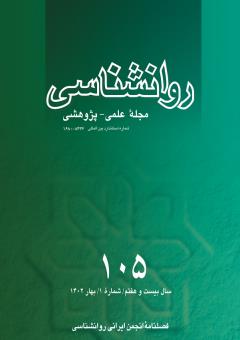طراحی پروتکل مشاوره توانبخشی مبتنی بر رواندرمانی پویشی کوتاهمدت بر اساس تجارب افراد دارای آلبینیسم: یک مطالعه ترکیبی
محورهای موضوعی : روانشناسی
طاهر علیزاده
1
![]() ,
بهمن بهمنی
2
*
,
بهمن بهمنی
2
*
![]() ,
محمد سعید خانجانی
3
,
محمد سعید خانجانی
3
![]() ,
منوچهر ازخوش
4
,
منوچهر ازخوش
4
![]() ,
شیما شکیبا
5
,
محسن واحدی
6
,
شیما شکیبا
5
,
محسن واحدی
6
1 - دانشجوی دکترای مشاوره توانبخشی، دانشگاه علوم توانبخشی و سلامت اجتماعی، تهران، ایرا ن
2 - گروه مشاوره، دانشگاه علوم توانبخشی و سلامت اجتماعی، تهران، ایران
3 - گروه مشاوره، دانشگاه علوم توانبخشی و سلامت اجتماعی، تهران، ایران
4 - گروه مشاوره، دانشگاه علوم توانبخشی و سلامت اجتماعی، تهران، ایران
5 - گروه روانشناسی بالینی، دانشگاه علوم توانبخشی و سلامت اجتماعی، تهران، ایران
6 - گروه آمار زیستی، دانشگاه علوم توانبخشی و سلامت اجتماعی، تهران، ایران
کلید واژه: تجربه زیسته, افراد دارای آلبینیسم, پروتکل مشاوره توانبخشی,
چکیده مقاله :
هدف از پژوهش حاضر طراحی پروتکل مشاوره توانبخشی مبتنی بر رواندرمانی پویشی کوتاهمدت بر اساس تجارب افراد دارای آلبینیسم بود. نوع پژوهش حاضر ترکیبی، از نوع کاربردی و در بخش کیفی به روش تحلیل محتوا بود. جامعه آماری این پژوهش افراد دارای آلبینیسم در سال 1399 بودند. تعداد 13 نفر از افراد دارای آلبینیسم به شکل هدفمند برای شرکت در مطالعه انتخاب شدند. جهت جمعآوری دادهها در بخش کیفی از مصاحبه نیمهساختاریافته استفاده شد و دادهها با نرمافزار MAXQDA تحلیل شدند. بهمنظور سنجش روایی محتوایی پروتکل تدوین شده از ضریب روایی لاوشه استفاده شد. تعداد 3 مضمون اصلی و 29 مضمون فرعی از مصاحبهها حاصل شد. سپس با بررسی و مطالعه متون مرتبط با درمانهای پویشی، پروتکل مشاوره توانبخشی مبتنی بر رواندرمانی پویشی کوتاهمدت در 3 فاز تدوین شد و جهت بررسی روایی محتوایی در اختیار 9 نفر از رواندرمانگران پویشی کوتاهمدت گرفت. باتوجهبه تأیید این پروتکل آموزشی توسط متخصصان، میتوان از پروتکل تهیه شده بهعنوان یک مداخله توانبخشی برای افراد دارای آلبینیسم استفاده کرد.
This research aimed to design a rehabilitation counseling protocol based on short-term dynamic psychotherapy according to the experiences of people with albinism. The current type of research was mixed, applied, and qualitative in the content analysis method. The statistical population of this research was people with albinism in 2019. 13 people with albinism were purposefully selected to participate in the study. To collect data in the qualitative part, semi-structured interviews were used and the data were analyzed with MAXQDA software. To measure the content validity of the developed package, the validity coefficient of Lavshe was used. 3 main themes and 29 secondary themes were obtained from the interviews. Then, by reviewing the study of literature and psychodynamic approaches, a rehabilitation counseling protocol based on short-term dynamic psychotherapy was developed in 3 phases, and it was given to 9 short-term dynamic psychotherapists to check its content validity. According to the approval of this protocol by experts, the prepared protocol can be used as a rehabilitation intervention for people with albinism
Aborisade, R. A. (2021). “Why Always me?”: Childhood Experiences of Family Violence and Prejudicial Treatment against People Living with Albinism in Nigeria. Journal of Family Violence 36(8), 1081–1094. https://doi.org/10.1007/S10896-021-00264-7
Barankin, B., & DeKoven, J. (2002). Psychosocial effect of common skin diseases. Canadian Family Physician, 48(4), 712-716. PMID: 12046366; PMCID: PMC2214020
Burke, J., Kaijage, T. J., & John-Langba, J. (2014). Media Analysis of Albino Killings in Tanzania: A Social Work and Human Rights Perspective. Ethic and social welfare 8(2), 117–134. https://doi.org/10.1080/17496535.2014.895398
Cruz-Inigo, A. E., Ladizinski, B., & Sethi, A. (2011). Albinism in Africa: stigma, slaughter and awareness campaigns. Dermatologic Clinics, 29(1), 79–87. https://doi.org/10.1016/J.DET.2010.08.015
Federico, J. R., & Krishnamurthy, K. (2018). Albinism. StatPearls Publishing
Franklin, A., Lund, P., Bradbury-Jones, C., & Taylor, J. (2018). Children with albinism in African regions: their rights to “being” and “doing.” BMC International Health and Human Rights, 18(1). https://doi.org/10.1186/S12914-018-0144-8 Frederickson, J. (2013.). Co-creating change: effective dynamic therapy techniques. Seven Leaves Press
Graneheim, U. H., & Lundman, B. (2004). Qualitative content analysis in nursing research: concepts, procedures and measures to achieve trustworthiness. Nurse Education Today, 24(2), 105–112. https://doi.org/10.1016/J.NEDT.2003.10.001
Jhetam, S., & Mashige, K. P. (2019). Ocular findings and vision status of learners with oculocutaneous albinism. African Vision and Eye Health, 78(1), 6. https://doi.org/10.4102/AVEH.V78I1.466
Kovacs, G. S. (1996). Impact of projective identification, shame proneness, level of empathy, and self-esteem on couple relationship satisfaction. California School of Professional Psychology-Los Angeles.
Levy, K. N., Meehan, K. B., & Yeomans, F. E. (2012). An update and overview of the empirical evidence for transference-focused psychotherapy and other psychotherapies for borderline personality disorder. Psychodynamic Psychotherapy Research: Evidence-Based Practice and Practice-Based Evidence, 139–167. https://doi.org/10.1007/978-1-60761-792-1_8/COVER
Lynch, P., Lund, P., & Massah, B. (2014). Identifying strategies to enhance the educational inclusion of visually impaired children with albinism in Malawi. International Journal of Educational Development, 39, 216–224. https://doi.org/10.1016/J.IJEDUDEV.2014.07.002
Peretz, J. R., Mccullough, L., Kuhn, N., Kaplan, A., & Hurley, C. L. (2007) Treating affect phobia: a manual for short-term dynamic psychotherapy. The Guilford Press
Lawshe, C. H. (1975). A quantitative approach to content validity. Personnel Psychology, 28(4), 563–575. https://doi.org/10.1111/j.1744-6570.1975.tb01393.x
Stadter, Michael. (2009). Object relations brief therapy: the therapeutic relationship in short-term work. Jason Aronson
Suzuki, T., & Tomita, Y. (2008). Recent advances in genetic analyses of oculocutaneous albinism types 2 and 4. Journal of Dermatological Science, 51(1), 1–9. https://doi.org/10.1016/J.JDERMSCI.2007.12.008
Vivar, K. L., & Kruse, L. (2018). The impact of pediatric skin disease on self-esteem. International Journal of Women’s Dermatology, 4(1), 27. https://doi.org/10.1016/J.IJWD.2017.11.002
Xie, Q. W., Xiaolu, D., Tang, X., Chan, C. H. Y., & Chan, C. L. W. (2019). Risk of mental disorders in children and adolescents with atopic dermatitis: A systematic review and meta-analysis. Frontiers in Psychology, 10, 1773. https://doi.org/10.3389/FPSYG.2019.01773/BIBTEX
Zahn, R., Lythe, K. E., Gethin, J. A., Green, S., Deakin, J. F. W., Young, A. H., & Moll, J. (2015). The role of self-blame and worthlessness in the psychopathology of major depressive disorder. Journal of affective disorders, 186, 337-341. https://doi.org/10.1016/j.jad.2015.08.001

